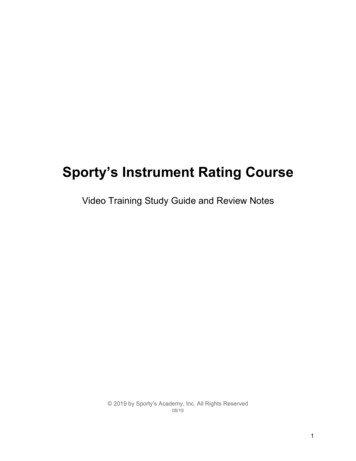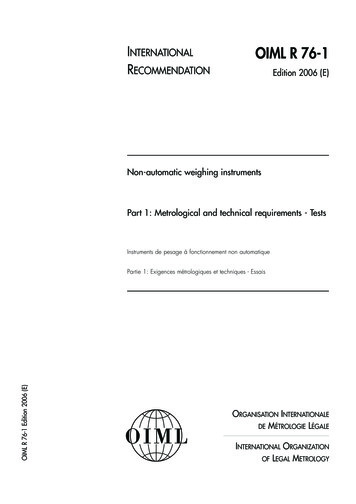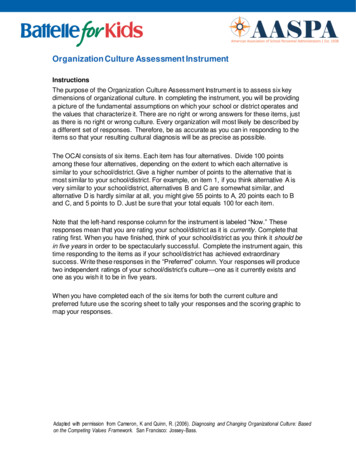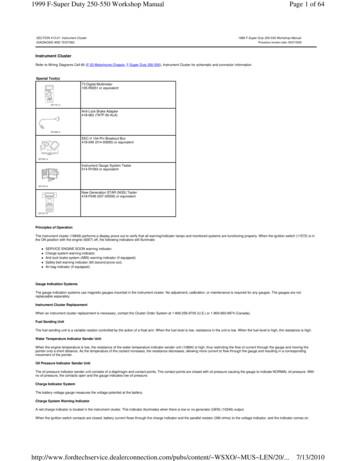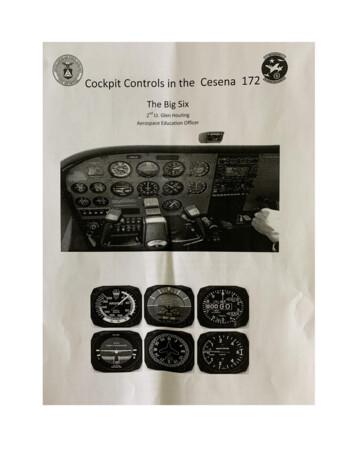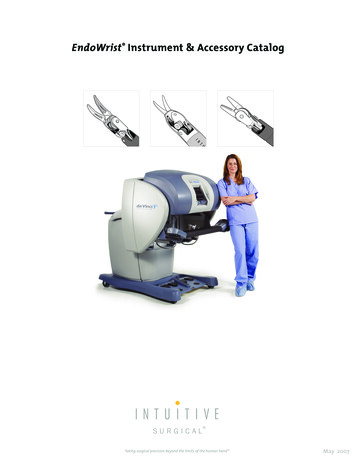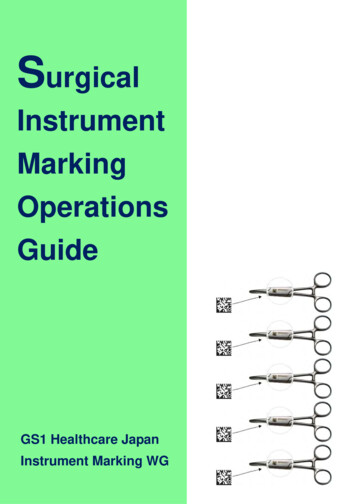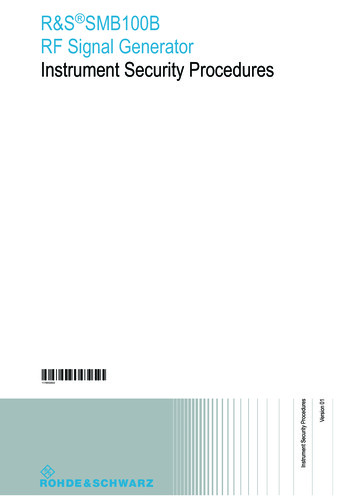
Transcription
R&S SMB100BRF Signal GeneratorInstrument Security Procedures(;ÜèJ2)Version 01Instrument Security Procedures1178902602
R&S SMB100BOverview1 OverviewIn many cases, it is imperative that the R&S SMB100B RF signal generators are usedin a secured environment. Generally these highly secured environments do not allowany test equipment to leave the area unless it can be proven that no user informationleaves with the test equipment. Security concerns can arise when devices need toleave a secured area e.g. to be calibrated or serviced.This document describes the types of memory and their usage in the R&S SMB100B.It provides a statement regarding the volatility of all memory types and specifies thesteps required to declassify an instrument through memory clearing or sanitization procedures. These sanitization procedures are designed for customers who need to meetthe requirements specified by the US Defense Security Service (DSS).2 Instrument Models CoveredTable 2-1: RF signal generator modelsProduct nameOrder numberR&S SMB100B1422.1000K023 Security Terms and DefinitionsClearingThe term "clearing" is defined in Section 8-301a of DoD 5220.22-M, "National IndustrialSecurity Program Operating Manual (NISPOM)". Clearing is the process of eradicatingthe data on media so that the data can no longer be retrieved using the standard interfaces on the instrument. Therefore, clearing is typically used when the instrument is toremain in an environment with an acceptable level of protection.SanitizationThe term "sanitization" is defined in Section 8-301b of DoD 5220.22-M, "NationalIndustrial Security Program Operating Manual (NISPOM)". Sanitization is the processof removing or eradicating stored data so that the data cannot be recovered using anyknown technology. Instrument sanitization is typically required when an instrument ismoved from a secure to a non-secure environment, such as when it is returned for service of calibration.The memory sanitization procedures described in this document are designed for customers who need to meet the requirements specified by the US Defense Security Service (DSS). These requirements are specified in the "Clearing and Sanitization Matrix"in Section 14.1.16 of the ISFO "Manual for the Certification and Accreditation of Classified Systems under the NISPOM".Instrument Security Procedures 1178.9026.02 012
R&S SMB100BTypes of Memory and Information Storage in the R&S SMB100BVolatile MemoryInstrument declassificationThe term "instrument declassification" refers to procedures that must be undertakenbefore an instrument can be removed from a secure environment, for example whenthe instrument is returned for calibration. Declassification procedures include memorysanitization or memory removal, or both. The declassification procedures described inthis document are designed to meet the requirements specified in DoD 5220.22-M,"National Industrial Security Program Operating Manual (NISPOM)", Chapter 8.4 Types of Memory and Information Storagein the R&S SMB100BThe RF signal generator contains various memory components.The following table provides an overview of the memory components that are part ofyour instrument. For a detailed description regarding type, size, usage and location,refer to the subsequent sections.Table 4-1: Types of memory and information storageMemory dureSDRAM1 GByteTemporary information storagefor operating system andinstrument firmware, or RAMdisk for user dataVolatileYesTurn off instrument power256 Byte upto 4 MByteModule-specific data: Serial number Board internal correctiondataNon-volatileNoNone required(no user data)8 MByteBIOSNon-volatileNoNone required(no user data)1 GByte Yessee "Sanitizeinternal memory"on page 5(CPU board)EEPROM/Flash(one per module)Flash(CPU board)microSD memory card(CPU board) Instrument states, e.g.Non-volatileUSB port, LAN servicesand setupsInstrument internal correction dataUser data4.1 Volatile MemoryThe volatile memory in the instrument does not have battery backup. It loses its contents when power is removed from the instrument. The volatile memory is not a security concern.Removing power from this memory meets the memory sanitization requirements specified in the Clearing and Sanitization Matrix in section 5.2.5.5.5 of the ISFO ProcessInstrument Security Procedures 1178.9026.02 013
R&S SMB100BTypes of Memory and Information Storage in the R&S SMB100BNon-Volatile MemoryManual for the Certification and Accreditation of Classified Systems under the NISPOM.SDRAMThe SDRAM on the CPU board contains temporary information storage for operatingsystem and instrument firmware. The SDRAM loses its memory when power isremoved.Sanitization procedure: Turn off instrument power.4.2 Non-Volatile MemoryThe R&S SMB100B contains no user-accessible non-volatile memory, except for themicroSD memory card on the CPU board. The microSD memory card on the CPUboard can require a sanitization procedure, depending on specific conditions, seemicroSD memory card (CPU board).All other non-volatile memories of the R&S SMB100B are not a security concern.EEPROM/Flash (module memory)Every module, except the CPU board, is equipped with a persistent module memory,which can be EEPROM or Flash memory. These module memories contain modulespecific data, such as the serial number of the module and correction data. TheEEPROM does not hold user data nor can the user access the EEPROM storage.Sanitization procedure: None required (no user data).Flash (CPU board)The flash memory contains the BIOS. It is on the CPU board of the R&S SMB100B.This flash memory does not hold user data nor can the user access the flash memory.Sanitization procedure: None required (no user data).microSD memory card (CPU board)The R&S SMB100B saves user and application data on the microSD memory card permanently, provided the volatile mode on the instrument is disabled (default setting).If the volatile mode is enabled, no user data can be written to the internal memory permanently. Find more about setting the volatile mode in sections "Protecting data" and"Disk & Memory Security Settings" of the user manual www.rohde-schwarz.com/manual/smb100b.The microSD memory card holds the data and is non-volatile. Hence, data is noterased when power is removed from the instrument.Sanitization procedure: Sanitize internal memory procedure.Instrument Security Procedures 1178.9026.02 014
R&S SMB100BSecure Erase Procedures5 Secure Erase ProceduresBecause the volatile memory types are erased when power is removed from the RFsignal generator, they do not pose a security risk. The flash memories on the CPUboard contain no user data. Therefore, it is deemed that they do not pose a risk either.The microSD memory card on the CPU board does not lose its contents when power isremoved. It can contain user data.Sanitize internal memoryYou can sanitize the microSD memory card on the CPU board flash memory by executing the sanitizing procedure provided on the instrument:Access:1. Select "System Config Setup Security General".2. Select "Disk & Memory".3. Enable "Sanitize".4. Enter the "Security Password".5. Confirm with "Accept".Note: The default password is 123456. For more information, see section "Using theSecurity Settings" in the R&S SMB100B user manual (see www.rohde-schwarz.com/manual/smb100b).Instrument Security Procedures 1178.9026.02 015
R&S SMB100BInstrument DeclassificationSpecial Considerations for USB PortsThe Secure Erase Procedure meets the memory sanitization requirements specified inthe Clearing and Sanitization Matrix in section 14.1.16 of the ISFO Process Manual forthe Certification and Accreditation of Classified Systems under the NISPOM.6 Instrument DeclassificationBefore you can remove the RF signal generator from a secured area, e.g. to performservice or calibration, all classified user data needs to be removed.You can declassify the R&S SMB100B as follows: Execute the sanitization procedure, as described in Sanitize internal memory procedure.Following these steps removes all user data from theRF signal generator.The R&S SMB100B can now leave the secured area.These declassification procedures meet the needs of customers working in securedareas.Validity of instrument calibration after declassificationThe EEPROM is the only memory type used to hold permanent adjustment valuesrequired to maintain the validity of the R&S SMB100B's calibration.7 Special Considerations for USB Ports andLAN ServicesThere are special considerations for R&S SMB100B USB ports and LAN services toavoid unauthorized data access in a high-security location.The access states of the USB ports and LAN services are saved according toTable 4-1.7.1 Special Considerations for USB PortsUSB ports can pose a security risk in high-security locations. Generally, this risk comesfrom small USB pen drives, also known as memory sticks or key drives. They can beeasily concealed and can quickly read/write several GByte of data. To protect theinstrument against unauthorized data access, you can disable the USB interface.Instrument Security Procedures 1178.9026.02 016
R&S SMB100BSpecial Considerations for USB Ports and LAN ServicesSpecial Considerations for LAN PortsDisabling USB ports for writing user dataTo disable the write capability on the USB ports of the R&S SMB100B:1. Select "System Config Setup Security General".2. Select "Disk & Memory".3. Disable "USB Storage".4. Enter the "Security Password".5. Cofirm with "Accept".When disabled, no USB storage device is accepted by the instrument. After areboot of the instrument, the write capability on any USB memory device is disabled. Other non-memory USB devices (such as keyboards and mice) are notaffected.7.2 Special Considerations for LAN PortsTo protect the instrument against unauthorized data access in a high-security location,you can disable the LAN interface.Disabling LAN portsTo disable the LAN ports of the R&S SMB100B:1. Select "System Config Setup Security LAN Services".Instrument Security Procedures 1178.9026.02 017
R&S SMB100BSpecial Considerations for USB Ports and LAN Services2. Disable the "LAN" interface.3. Enter the "Security Password".4. Confirm with "Accept"When disabled, no LAN connection can be established with the instrument.For information concerning the security features, refer also to the R&S SMB100B usermanual. 2018 Rohde & Schwarz GmbH & Co. KGMühldorfstr. 15, 81671 München, GermanyPhone: 49 89 41 29 - 0Fax: 49 89 41 29 12 164Email: info@rohde-schwarz.comInternet: www.rohde-schwarz.comSubject to change – Data without tolerance limits is not binding.R&S is a registered trademark of Rohde & Schwarz GmbH & Co. KG.Trade names are trademarks of the owners.Throughout this manual, products from Rohde & Schwarz are indicated without the symbol , e.g.R&S SMB100B is indicated as R&S SMB100B.Instrument Security Procedures 1178.9026.02 018
The term "sanitization" is defined in Section 8-301b of DoD 5220.22-M, "National Industrial Security Program Operating Manual (NISPOM)". Sanitization is the process of removing or eradicating stored data so that the data cannot be recovered using any known technology. Instrument sanitization is typically required when an instrument is

